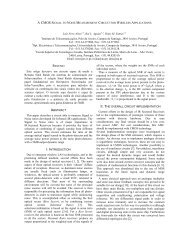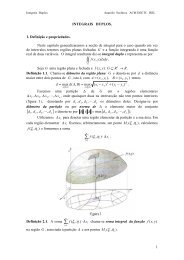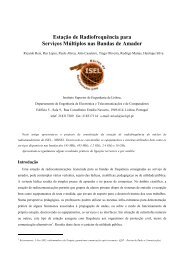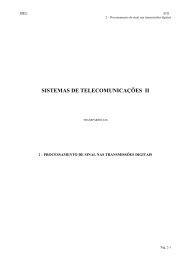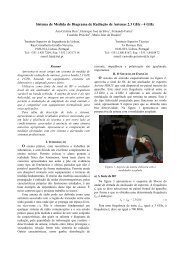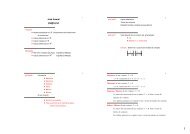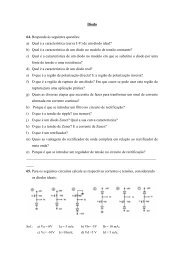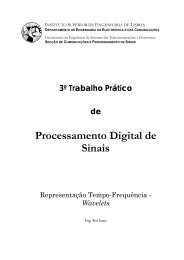Transformações Lineares de Rn em Rm - deetc
Transformações Lineares de Rn em Rm - deetc
Transformações Lineares de Rn em Rm - deetc
You also want an ePaper? Increase the reach of your titles
YUMPU automatically turns print PDFs into web optimized ePapers that Google loves.
T R A N S F O R M A Ç Õ E S L I N E A R E S D E R N E M R M A L G E B R A – T U R M A L R 1 1 D<br />
3. Como vimos, resulta da aplicação da transformação linear,<br />
w = Ax<br />
⎡w1<br />
⎤ ⎡cos(<br />
θ)<br />
⎢ ⎥ = ⎢<br />
⎣w2<br />
⎦ ⎣sen(<br />
θ)<br />
− sen( θ)<br />
⎤⎡x⎤<br />
cos( θ)<br />
⎥⎢<br />
⎥<br />
⎦⎣y<br />
⎦<br />
© Prof. José Amaral ALGA M06 - 23 12-11-2007<br />
2<br />
2<br />
T : R → R , w = T(<br />
x,<br />
y)<br />
que todos os objectos do plano sofr<strong>em</strong> uma rotação <strong>de</strong> θ no sentido directo.<br />
Consi<strong>de</strong>rando, por ex<strong>em</strong>plo, θ = π 4 , e aplicando a transformação ao ponto x = ( x,<br />
y)<br />
= ( 2,<br />
2)<br />
,<br />
resulta a imag<strong>em</strong><br />
w = Ax<br />
⎡cos(<br />
π 4)<br />
− sen( π 4)<br />
⎤ ⎡− 2⎤<br />
= ⎢<br />
⎥ ⎢ ⎥<br />
⎣sen(<br />
π 4)<br />
cos( π 4)<br />
⎦ ⎣ 2⎦<br />
⎡ 2 2 − 2 2⎤<br />
⎡2⎤<br />
⎡1 − 1⎤<br />
⎡2⎤<br />
⎡0⎤<br />
= ⎢<br />
⎥ ⎢ ⎥ = 2 2 ⎢ ⎥ ⎢ ⎥ = 2 2 ⎢ ⎥<br />
⎣ 2 2 2 2⎦<br />
⎣2⎦<br />
⎣1<br />
1⎦<br />
⎣2⎦<br />
⎣4⎦<br />
⎡ 0 ⎤<br />
= ⎢ ⎥<br />
⎣2<br />
2⎦<br />
figure(7);clf<br />
x=[2 2]'<br />
teta=pi/4;<br />
A = [cos(teta) -sin(teta); sin(teta) cos(teta)];<br />
w=A*x<br />
hold on<br />
plot(x(1),x(2),'*k');<br />
plot(w(1),w(2),'*r');<br />
axis([ -1 4 -1 4])<br />
hold off<br />
Na aplicação da transformação ao conjunto <strong>de</strong> pontos ( x 1 , y1)<br />
= ( 2,<br />
2)<br />
, ( x 2 , y2)<br />
= ( 2,<br />
3)<br />
,<br />
( x 3 , y3)<br />
= ( 3,<br />
3)<br />
, ( x 4 , y4<br />
) = ( 3,<br />
2)<br />
figure(8);clf<br />
x1=[2 2]'; x2=[2 3]'; x3=[3 3]'; x4=[3 2]';<br />
X=[x1 x2 x3 x4]<br />
teta=pi/4;<br />
A = [cos(teta) -sin(teta); sin(teta) cos(teta)];<br />
W=A*X<br />
hold on<br />
plot(X(1,:),X(2,:),'*k');<br />
plot(W(1,:),W(2,:),'*r');<br />
axis square; axis equal<br />
axis([ -1 4 0 5]); hold off<br />
, ou a qualquer outro conjunto <strong>de</strong> pontos - consi<strong>de</strong>r<strong>em</strong>os por ex<strong>em</strong>plo o caso do quadrado




